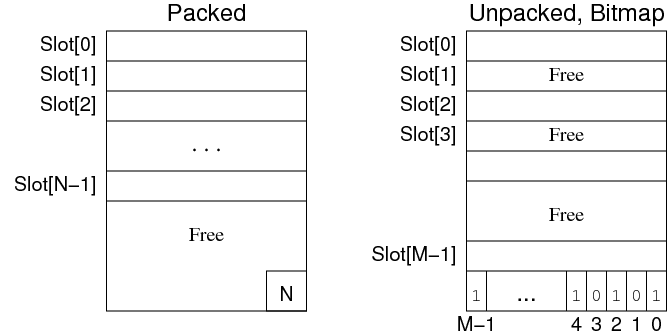Page Internals
Pages
Database applications view data as:
- Collection of records/tuples.
- Records can be accessed via
TupleId/RecordId/RID. TupleId = PageID + TupIndex.
The disk and buffer manager provide the following view:
- Data is a sequence of fixed-size pages (aka blocks).
- Pages can be random-accessed via a
PageID. - Each page contains zero or more tuple values.
Page format = how space/tuples are organised within a page.
Data files consist of pages containing tuples:

Each data file (in PostgreSQL) is related to one table.
Page Operations
A Page is simply an array of bytes (byte[]). We want to interpret/manipulate it as a collection of Records (tuples).
Tuples are addressed by a record ID (rid = (PageId, TupIndex)).
Typical operations on Pages:
request_page(pid): get page viaPageID.get_record(rid): get record via itsTupleId.rid = insert_record(pid, rec): add new record.update_record(rid, rec): update value of record.delete_record(rid): remove record from page.
Page Formats
Page format = tuples + data structures allowing tuples to be found.
Characteristics of Page formats:
- Record size variability (fixed, variable).
- How free space within
Pageis managed. - Whether some data is stored outside
Page/- Does
Pagehave an associated overflow chain? - Are large data values stored elsewhere? (e.g. TOAST).
- Can one tuple span multiple
Pages.
- Does
Fixed-Length Records
For fixed-length records, use record slots:
- Insert: place new record in first available slot.
- Delete: two possibilities for handling free record slots:

In the packed representation, there are no empty slots between filled slots. We simply add the record to the end.
- Makes inserting easy as we simply append to the end.
- Deleting is harder as the data must be compacted.
In the unpacked representation, there may be empty slots between filled slots. A bitstring must hence be stored to determine what slots are free.
- Makes insert harder as we have to find a free slot.
- Deleting is easier, as we simply clear out that slot.
Variable-Length Records
For variable-length records, must use slot directory.
Possibilities for handling free-space within block:
- Compacted (one region of free space).
- Fragmented (distributed free space).
In practice, combination is useful:
- Normally fragmented (cheap to maintain).
- Compacted when needed (e.g. record won’t fit).
Important aspect of using slot directory:
- Location of tuple within page can change, tuple index does not change.
Compacted free space:

Fragmented free space:

Storage Utilisation
The number of records that can fit on a page (with C denoting capacity) depends on:
- Page size.
- Record size.
- Page header data.
- Slot directory.
Overflows
Sometimes it may not be possible to insert a record into a page:
- No free-space fragment large enough.
- Can first try to compact free-space within page.
- If still insufficient space, need alternative solution.
- Overall free-space is not large enough.
- Can be handled by making new page.
- Record is larger than page.
- Requires overflow file.
- No more free directory slots in page.
- Can be handled by making new page.
Overflow Files for Large Records and BLOBs

Record-based Handling of Overflows
